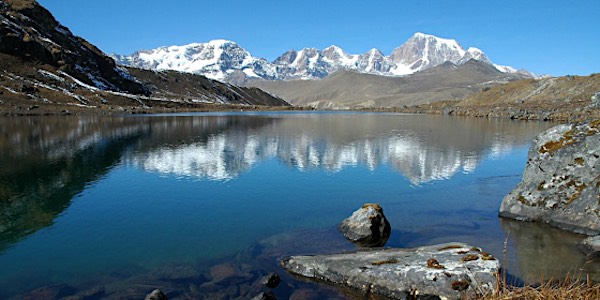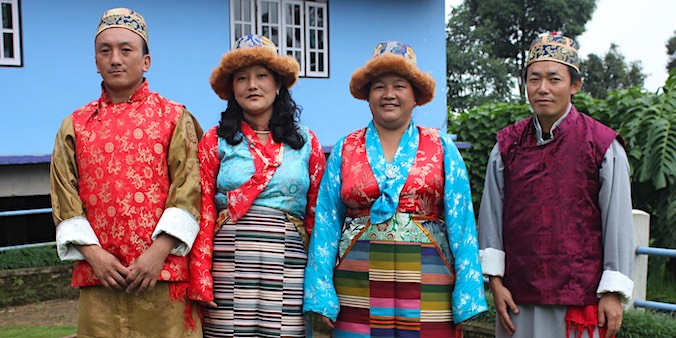BICYCLE TOUR NORTH and WEST SIKKIM
Tour - 19 days/ 16 days bicycling
About Darjeeling & SIKKIM
Sikkim and neighboring Darjeeling have a lot to offer to mountain lovers, aficionados of Buddhist culture and trekkers. Wedged in between Nepal, Bhutan and Tibet – but part of India – this region shares a lot with these areas.
Darjeeling, situated at 2040m, has the typical atmosphere of Indian hill stations. It was the former summer capital of British India, and has preserved much of the old-world charm. Darjeeling is world-famous for its tea, which is grown in extensive tea estates that clad the surrounding slopes. Being very close to the tallest mountains on earth, especially number 3, the Kangchenjunga (8586m) it also boasts great views from most hotel windows.
It’s next-door neighbour Sikkim – of which it used to be part – is a gem of cultural and natural diversity. Until 1974 Sikkim was an independent kingdom, now it is part of India. It is home to different Himalayan peoples, most from Nepali descent or originating from Tibetan and Bhutan, such as the Bhutias who brought Buddhism to the area four centuries ago. Thanks to them Sikkim boasts of colorful Buddhist monasteries and Buddhist festivals. The Lepcha’s, until a few decennia ago forest-dwelling animists, hold a unique culture that the Sikkimese government is trying to preserve.
Read more…Read less…
Region
Darjeeling & Sikkim
(India)
Best Time
March-April &
Oct-Dec
No. Of Days
19 days, 16 days bicycle trek
Trip Character
Bicycle tour
Sleeping Altitude
1620 - 2625 m
Bicycle Trek Character
Homestays & guesthouses
Bicycle tour: level 3
Price
INR XXX/ $ XXX
ABOUT THIS TOUR
On this tour, you’ll fly from Delhi to Bagdogra, south of Sikkim, from where you’ll be driven to Gangtok, Sikkim’s capital. After two nights here, to rest from the journey and get acclimatised to the altitude, the bicycle tour starts.
On the first leg of the tour, you’ll explore the ‘monastic circuit of western Sikkim, visiting the most interesting and precious Buddhist temples and monasteries of Sikkim, as well as its diverse people and mountains and its fascinating flora and fauna. Where possible, you follow remote roads, avoiding dense traffic routes, that wind their way through the lush countryside and forests. Occasionally you will get very good views of the Khangchenjunga (8485 m) and other Himalayan peaks.
On the second leg you’ll explore the most northern parts of Sikkim. You’ll bicycle up along the raging Teesta River and explore small settlements along its headwaters, inside the Kangchenjunga National park. Even further north, you’ll visit the Bhutia settlements of Lachen and Lachung, situted at about 2600m. From here, you’ll explore the highest attainable valleys of Sikkim, close to the border with Tibet/ China and home to yak herders and ancient, tiny gompas that figure in early twentieth century travel stories by legendary explorers such as Alexandra David-Neel and Lama Anagarika Govinda.
Your accommodation is a mix of pleasant homestays, ‘different’ ecoresorts and comfortable hotels.
YOUR custom-made TRIP
The tour described here, as well as the other ones on our website, are mainly meant as suggestions. We would be happy to offer you a travel proposal that fully meets your personal demands and expectations. That means that you choose where you want to go, what level of accommodation and type of transport you want and what activities you prefer.
Please let yourself be inspired by this and other trips on our website and then drop us a line (or call us) to explain your travel wishes. We will be happy to help you put together the perfect trip. You can reach us over e-mail, Messenger, Whatsapp or mobile phone.
EXTENSIONS & VARIATIONS
Apart from the tour as described here, you could consider the following add-ons and changes:
- Stay longer in Gangtok or one of the smaller hamlets that you pass through on the way. Gangtok has a lot to offer in terms of local sights, such as monasteries and temples, handicraft markets, shopping and pleasant cafes. The smaller places, such as Kewzing, Yuksum, Lachen and Lachung is where you can meet the locals and learn about their culture.
- Add a walking trek to your programme to get even higher into the Himalayas and enjoy stupendous vistas of Mt. Kangchenjunga. We highly recommend the Shingalila Ridge trek.
- If you’re into really long bicycle tours, we can organise a combination of Sikkim, Assam and Arunachal Pradesh. Or, combine your tour in Sikkim with exploring neighbouring Nepal or Bhutan. Ask us for suggestions.
Route Map
ITINERARY
-
.fa-info {color: #1146a9;}.fa-info:hover {color: #387dff;}Day 1: Delhi ✈︎ Bagdogra or Pakyong Aiport & drive to Gangtok (4, or 1 hr drive resp.)
The flight to Bagdogra takes less than 2 h and, in clear weather, affords wonderful views of the Himalayas, including Mt. Everest (8848m) and Kangchenjunga (8568m). At the airport our guide and driver await you, and will take you to Gangtok, Sikkim's Capital. Overnight in a good hotel. Altitude 1650m. -
Day 2: In Gangtok
No biking yet today, at least not if you don’t want to. Early morning, we can witness a spectacular sunrise over the Kanchenjunga range from the Tashi View Point near the city. Later, we visit some of the sights, as mentioned in the highlight. Altitude 1650m. -
Day 3: Gangtok – Rumtek (biking 19 km, +750, -750m)
This first day of biking is easy, so as to get you into the swing. Leaving Gangtok to the west, you descend to the river rani Khola, after which about 550m climbing brings you to the forested mountain slopes surrounding Rumtek, the site of Gangtok's most famous monastery, Rumtek Gompa.
After lunch you can visit the monastery. Altitude 1650 → 1650m.

-
Day 4: Rumtek - Temi (biking 39.5 km, +1095m, -1740m)
Today, you’ll follow a backroad north of the Siliguri-Gangtok highway, along small hamlets, dropping down to the Teesta River. After crossing this, a climb of almost 1000m brings you to Temi Tea Gardens. You can visit
the gardens and the tea factory (if open). Altitude 1650 → 350 → 1020m.

-
Day 5: Temi - Kewzing (biking 30 km, +1290m, -695m)
Today is a relatively short day. It's a steady 800m climb to Ravangla, situated at mountain saddle at 2030m. Here, you can visit the Buddha Park, which boast as 40m high statue of the Buddha Gautama. From here, it is only 9 km
down to Kewzing, today's halting place. Altitude 1020 → 2045 → 1615m.

-
Day 6: Kewzing - Pelling (biking 38.5 km, +1635m, -1315m)
First, a 1100m drop over 24km to the Rangit River awaits you. Then, as could be expected, it’s climbing again, unto the small town of Pelling, home to Sikkim’s most revered monastery, Pemayangtse Gompa.
Altitude 1615 → 2030 → 1935m.

-
Day 7: Pelling – Pemayangtse - Kechopalri Lake - Yuksom (biking 52 km, +1870m, -2075m)
After an extended visit to the famous Pemayangtse Monastery, we continue to Yuksom, the ancient capital of Sikkim and trailhead for treks towards Khangchenjunga. On the way, we take a side trip to the beautiful Khechopari Lake,
perhaps the holiest lake in Sikkim. Overnight stay in Yuksom. 1935 → 1160 → 1825 → 1105 → 1730m.

-
Day 8: Yuksom - Tashiding Monastery - bridge - Ravangla (biking 53,5 km, +1975m, -1660m)
The first part of today’s ride, from Yuksom to Tashiding, home to spectacularly located Tashiding Monastery, is overall downhill. After crossing the Rangit River over a hanging bridge (650m), and climbing 1000m to Kewzing,
a short descent brings you to Ravangla. Altitude 1730 → 1345 → 1605 → 655 → 2045m.

-
Day 9: Ravangla – Mangan - (biking 72.5 km, +1870, -2690)
A long day, following less traveled roads. You descend all the way down to the Teesta River again and, after crossing it, head north along the river up to the town of Mangan.
Here, you'll stay at a comfortable lodge. Altitude 2045 → 460 → 920 → 595 → 935 → 755 → 1250m.

-
Day 10: Mangan - Sakkyong (biking 23.5 km, +1110m, -895m)
Today, you''ll leave the main road and explore a less visited valley to the west. It's a relatively short distance to the simple homestay up in Sakkyong Valley. After lunch you'll walk further west and explore the fringes of theKangchenjunga National Park. Altitude 1250 → 750→ 1450m.

-
Day 11: Sakkyong - Chumthang (biking 53 km, +1830m, -1690m)
You leave this beautiful valley again and rejoin the main road at Mangan. Continuing north along the river,
it's a steady climb to the small town of Chumthang. Altitude 1450 → 750→ 1620m.

-
Day 12: Chumthang - Lachen (biking 26 km. +1615m, -585m)
You travel further north, entering the wide Lachen Valley, one of the two major
acces routes to the borderlands with Tibet. Altitude 1620 → 2025 → 2620m.

-
Day 13: Lachen - Thangu - Lachen (biking & car 105 km, +3090m, -3090m)
A long day with a very serious altitude gain., so you may want to ride the car for at least a part of it. You'll follow one of the main access routes to the high Himalayas on the border with Tibet/ China, a magnificent area of glaciers, forbidding mountains and
green valleys where yaks graze. Altitude 2620 → 5015 → 2620m.

-
Day 14: Lachen - Lachung (81,5 km, +1710m, -1705m)
You return to Chumthang, where you turn east. Climbing up another valley you’ll reach the pleasant settlement of Lachung.
Altitude 2620 → 1620 → 2625m.

-
Day 15: Lachung - Zero Point - Lachung (biking & driving 117 km, +2785, -2785m)
Today we explore the desolate, high-altitude valley north of Lachung, again by car and bicycle. The landscape is shaped by glaciers, raging mountain streams, moraines and snow-capped mountains rising above 6,000 meters. The forests harbour mainly silver fir and juniper, but also more than twenty
species of rhododendrons (blooming in April). Altitude 2625 → 4815 → 2625m.

-
Day 16: Lachung - Milky Waterfall - Lachung (biking & driving 74 km, +2220, -2220m)
In the morning you can visit the interesting Lachung Gompa (temple) before bicycling up to Milky Waterfall, a sturdy climb that leads through beautiful virgin forests.
species of rhododendrons (blooming in April). Altitude 2625 → 4060 → 2625m.

-
Day 17: Lachung - Mangan (biking 51 km, +730m, -2185m)
Returning to Mangan makes for an easy day,
as most of the stretch is descending. Altitude 2625 → 1250m.

-
Day 18: Mangan - Gangtok (biking 53 km, +1900, -1415)
You follow the main, eastern road back to Gangtok, stopping at wonderful viewpoints
and the interesting monastery of Phodong. Altitude 1250 → 750 → 940 → 585 → 1650m.

-
Day 19: Gangtok - Bagdogra ✈︎ Delhi (4 h drive, 2 h flight)
After breakfast the car will take you down to Bagdogra where you check in for the flight to Delhi. It depends on the timing of your international flight whether you will need an overnight stay in Delhi. In the latter case we can arrange this for you.
HIGHLIGHTS OF THIS TOUR
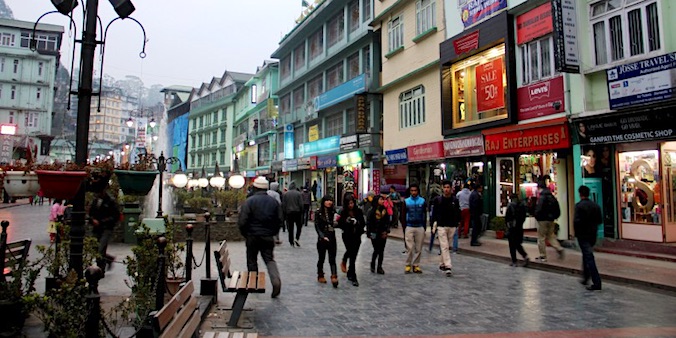
Gangtok
In Sikkim’s capital Gangtok, the rear neighbours almost always live on another street and hardly anyone has a garden, because the slopes are too steep for that. This also means that the roads are nowhere wide and often clogged. But fortunately most locations in the city can be reached on foot. Pedestrians can use a whole series of footbridges to cross busy roads. Gangtok was also the first city in India to declare its centre a pedestrian area. Here it is pleasant to stroll and shop and there are numerous ‘hip’ restaurants and cafes. Thanks to the government’s serious approach to environmental problems – a rarity in India – this is also one of India’s cleanest city centres. Interesting places to visit include the flower exhibition – with many varieties of orchids, – the Institute of Tibetology, Enchey Gompa and Tashi Viewpoint.
Rumtek Monastery
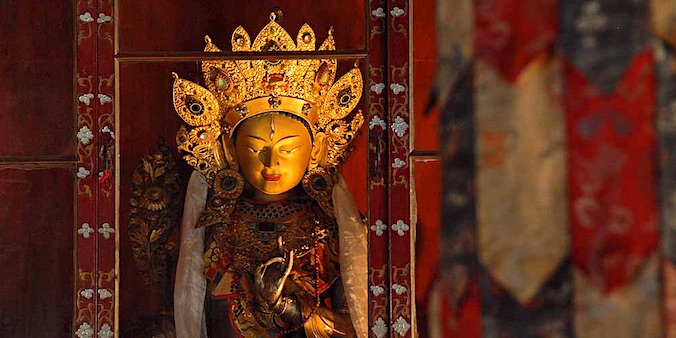
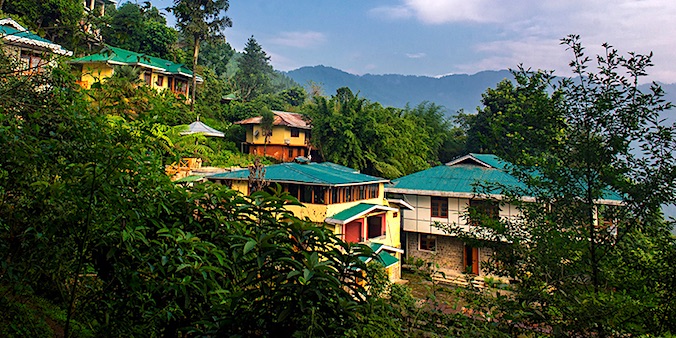
Teen Taley Eco Resort
Teentaley Eco Resort is not a hotel but, as they say “an organic experience of the real, rural Sikkim.” Here, you stay in cozy bamboo cottages amidst a sprawling landscape garden, with a farmhouse and a private forest where you can go bird watching without leaving the premises. The food is home-grown, organic of course, and dinners are accompanied with the typical Sikkimese tongba – bamboo containers filled with millet beer. As the location, in Rumtek, is close to Gangtok, you can stay here, sleeping in the quiet of the mountains and waking to the birds’ songs, while visiting Sikkim’s capital during the day.
SIKKIM Tea
If there is one legacy of the Brits in India it is tea. Tea estates, tea processing and exporting, and tea drinking. It was long believed that wild tea, Camelia sinensis, only grew in China, but this small woody brush was ‘rediscovered’ by the British in the early 19th century in the jungle of Assam. Camelia sinensis var. assamica had long been used by indigenous people. Large tracts of land were converted into tea gardens and these days Darjeeling (and Assam) tea are known worldwide. There are two kinds of preparation. The black tea that is being dunked in water that just has been boiled is called orthodox. In Indian households and tea stalls the tea is generally boiled for some time with milk and sugar, and sometimes spices. This is called CTC tea. The two kinds of tea require different factory handling, but both have the same Camelia leaves as the starting point.

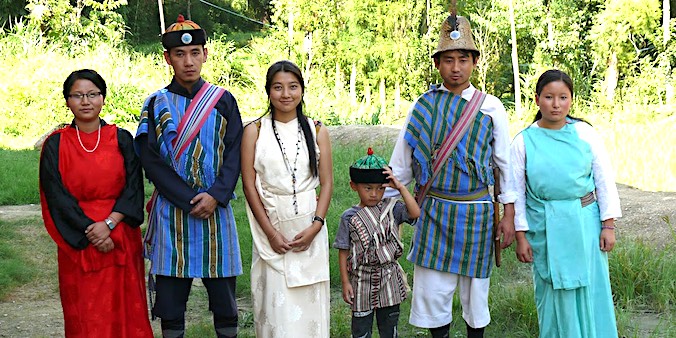
The Lepchas
Ravangla
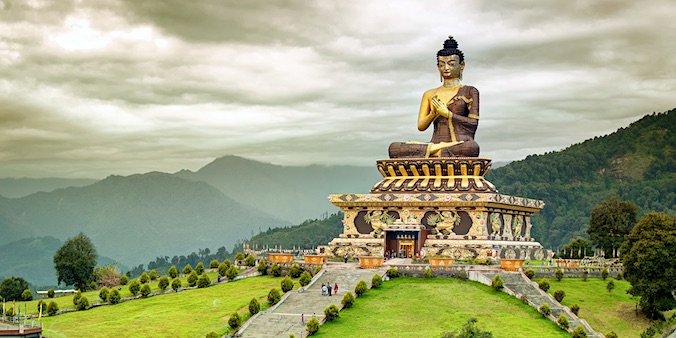
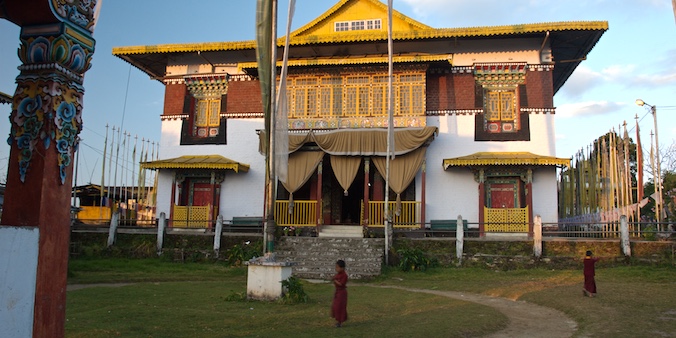
Pemayangtse Monastery
Lachen and Lachung
